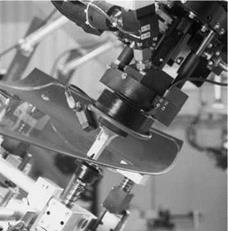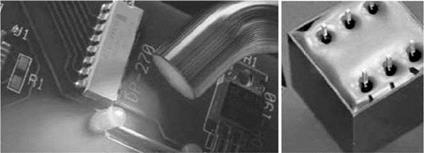In particular, elastic polyurethane adhesives that cure under the effect of moisture are widely used in the automotive and building industries. The introduction of adhesives in automotive glazing (e. g. adhesive fitting of windshields) has provided a significant increase in the rigidity of the bodywork compared to the use of nonadhesive, rubber seals. Today, the bonding process in this field ofapplication is highly automated, and includes robotic application of the primer, adhesive bead application and accurate positioning and joining of the windshield element (Figures 6.22 and 6.23).
|
Figure 6.22 Adhesive application in the bonding of a car windshield. (Photo courtesy of KUKA Schweissanlagen GmbH). |
For the bonding of smaller components in medical and electronic applications, one-part adhesives that are cured by UV radiation are widely used (Figure 6.24). The specific interaction between the photoinitiator used and the high-energy UV radiation allows a very rapid curing process, down to fractions of seconds of exposure time (see Section 8.14).
UV light sources for radiation curing range from light-emitting diodes (LEDs) to small mobile mercury pressure lamps with optical conductors for medical applications in dentistry, to large systems for use on assembly lines. The most popular light
|
Figure 6.23 Handling of car windshields by robots during adhesive application. (Photo courtesy of KUKA Schweissanlagen GmbH). |
|
Figure 6.24 UV-curing of adhesive using a fiber optic conductor. (Photo courtesy of Ellsworth Adhesives). |
sources are electrode-excited or microwave-excited mercury lamps, and microwave- excited excimer lamps. The following parameters influence the total dose and maximum intensity of UV radiation to be controlled:
• speed of the conveyor belt or throughput speed
• distance between the lamp and the conveyor belt
• initial performance and aging of the lamp
The UV dose available on the surface of the substrate consists of the direct lamp radiation and the reflected radiation. Commercial UV devices are available with different reflector types. Below a wavelength of 240 nm, short-wave UV-C radiation generates ozone that, on an industrial scale, may necessitate treatment of the exhaust air for reasons of health and environmental safety. For the in-line control of UV radiation intensity, UV sensors with a good long-term stability are available from different manufacturers.
 9 октября, 2015
9 октября, 2015  Pokraskin
Pokraskin 


 Опубликовано в рубрике
Опубликовано в рубрике 